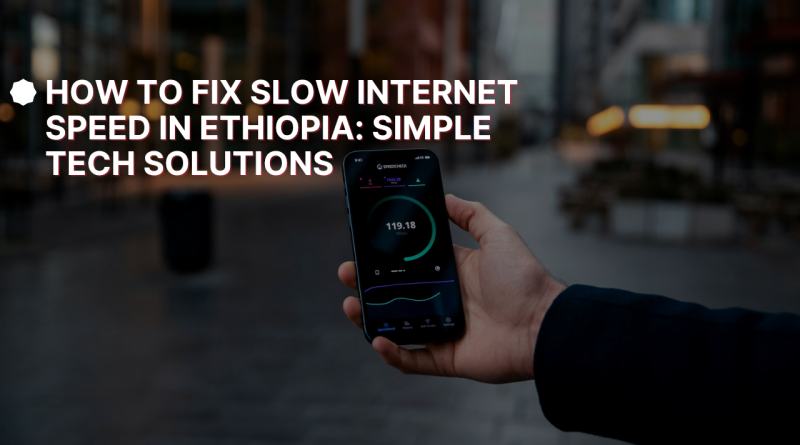How to Fix Slow Internet Speed in Ethiopia: Simple Tech Solutions
In Ethiopia, internet connectivity plays a vital role in education, business, communication, and entertainment. Yet, many users face the frustration of slow internet speeds, which can hamper productivity and overall online experience. Whether you are streaming videos, attending online classes, working remotely, or simply browsing social media, slow internet can be a major obstacle.
Fortunately, there are practical and easy-to-follow tech solutions to fix or at least improve slow internet speed in Ethiopia. This guide will help you understand the common causes of slow internet and offer actionable tips to optimize your connection for better speed and reliability.
Why Is Internet Speed Slow in Ethiopia?
Before diving into solutions, it’s crucial to understand why internet speeds can be slow in Ethiopia:
1. Infrastructure Challenges
Ethiopia’s internet infrastructure is still developing. While fiber optic networks are expanding, many areas rely on older technologies like DSL or mobile networks with limited bandwidth.
2. High Network Traffic and Congestion
During peak hours, many users share the same network resources. This causes congestion, which reduces individual internet speed.
3. Limited Bandwidth Plans
Some internet packages come with limited bandwidth or speed caps, especially on mobile data or home broadband plans.
4. Hardware and Router Issues
Outdated routers, improper placement, or faulty devices can weaken Wi-Fi signals and reduce internet speed.
5. Software and Device Problems
Malware, outdated software, or multiple devices connected simultaneously can consume bandwidth and slow down your connection.
How to Fix Slow Internet Speed in Ethiopia: Step-by-Step Solutions
Here are simple, effective tech solutions that you can try at home or office to boost your internet speed:
1. Test Your Current Internet Speed
Before making any changes, know your baseline speed. Use free, trusted speed testing tools like:
Knowing your speed helps identify if the problem is with your ISP or your setup.
2. Restart Your Modem and Router Regularly
Sometimes internet devices slow down due to overheating or temporary glitches. Restarting refreshes the connection.
How to restart:
- Turn off your modem and router.
- Unplug from the power source.
- Wait for 30 seconds to 1 minute.
- Plug them back in and power on.
Make it a weekly habit to keep your devices performing optimally.
3. Optimize Your Router Placement
Wi-Fi signals weaken due to physical obstacles and interference.
Tips for better placement:
- Place your router in a central, elevated location.
- Avoid thick walls, metal objects, and electronic devices (microwaves, cordless phones).
- Keep it away from windows to prevent signal loss outside.
4. Use Ethernet Cable for Devices When Possible
Wi-Fi signals degrade over distance and due to interference. For activities that require stable and fast internet (like gaming, video conferencing), connect your computer or smart TV directly via Ethernet cable. Wired connections are usually faster and more stable.
5. Update Your Router Firmware and Device Software
Manufacturers release updates that fix bugs and improve performance.
- Check your router’s admin panel (typically at IP
192.168.1.1or192.168.0.1) for firmware updates. - Keep your computer, smartphone, and apps updated.
- Regularly run antivirus and malware scans to remove any malicious software consuming bandwidth.
6. Limit Devices and Background Data Usage
Too many devices connected to the same network can slow speed.
- Disconnect devices not in use.
- Limit bandwidth-heavy activities (streaming, downloads) on multiple devices simultaneously.
- Use your router’s Quality of Service (QoS) settings (if available) to prioritize important applications or devices.
7. Upgrade to a Modern Router or Modem
Older routers might not support higher speeds or newer Wi-Fi standards.
- Consider upgrading to routers supporting Wi-Fi 5 (802.11ac) or Wi-Fi 6 (802.11ax).
- Ensure your modem/router supports the speed plan you pay for.
- Some Ethiopian ISPs, including Ethio Telecom, offer compatible routers with fiber-optic packages.
8. Use Data-Saving Browsers and Apps
Browsers like Google Chrome and Opera offer data-saving modes that reduce bandwidth usage, speeding up page loading on slow connections.
Use lite versions of apps (Facebook Lite, YouTube Go) designed to use less data and work better on slower networks.
9. Schedule Large Downloads During Off-Peak Hours
Internet speeds tend to improve late at night or early morning when fewer people are online.
Plan software updates, large file downloads, or backups during these times.
10. Consider a VPN (Virtual Private Network)
Sometimes ISPs throttle certain services or websites. Using a reputable VPN service like ExpressVPN or NordVPN can help bypass throttling, potentially improving speed.
Note: VPNs can also slow down your connection if the server is far or overloaded, so choose nearby, high-speed servers.
11. Check Your Internet Package and Upgrade if Needed
Sometimes the problem lies in the plan you subscribe to.
- Review your internet speed and data limits.
- Contact your ISP to inquire about higher-speed plans or promotions.
- Ethio Telecom, the main ISP in Ethiopia, offers various plans including fiber optic packages with faster speeds and higher data caps.
Additional Resources and Links
- For checking internet speeds: Speedtest by Ookla
- For choosing the right VPN: TechRadar’s Best VPN Services 2025
- Ethio Telecom official website: https://www.ethiotelecom.et
Final Thoughts
Slow internet speed in Ethiopia is a common challenge, but it can often be fixed or improved with simple tech solutions. Whether by optimizing your router setup, updating equipment, managing devices, or upgrading your internet package, you can enhance your online experience significantly.
Remember, consistent monitoring and simple maintenance habits like restarting your modem, clearing cache, and scheduling downloads can keep your internet running smoothly.
If you continue to experience slow speeds despite all efforts, it’s advisable to reach out to your ISP for assistance or consider alternative internet options such as mobile broadband.
